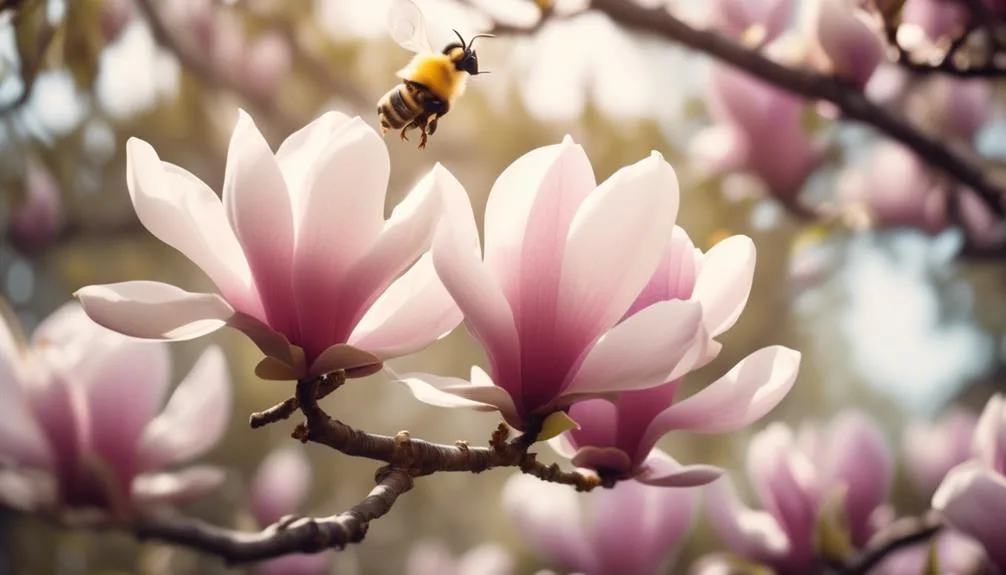Standing under a magnolia tree, you notice bees buzzing around the blossoms.
Ever wondered why these trees attract bees?
It's a mix of factors like nectar, pollen, and fragrance.
What exactly draws these buzzing visitors to magnolia trees?
Magnolia Tree Flowers
When you observe a magnolia tree in bloom, you'll be captivated by the large, fragrant flowers that adorn its branches. These flowers possess a unique floral anatomy, consisting of sturdy carpels and numerous stamens that hold the pollen.
The pollination process of magnolia trees is a fascinating sight to witness. As bees hover around the flowers, they brush against the stamens, picking up pollen on their bodies. When they visit another magnolia flower, this pollen is then transferred to the stigma, kickstarting the fertilization process.
The intricate floral anatomy of magnolia trees plays a crucial role in attracting bees for pollination. This process not only ensures the continuation of the magnolia tree species but also provides nourishment for the bees in the form of nectar.
Nectar Production
Magnolia trees produce nectar to attract bees for pollination, serving as a vital energy source for these essential pollinators. Nectar secretion is a crucial aspect of the magnolia tree's reproductive strategy, as it entices bees and other insect pollinators to visit the flowers, facilitating the transfer of pollen from one bloom to another. This process ensures the fertilization and development of new seeds within the magnolia's cone-like fruits. The nectar's sweetness acts as a reward for the bees, motivating them to continue visiting the flowers and aiding in the tree's reproduction. The table below illustrates the significance of nectar production in fostering this symbiotic relationship between magnolia trees and bees.
| Nectar Production | Importance |
|---|---|
| Sweet nectar | Vital energy source for bees |
| Entices pollinators | Facilitates pollination process |
| Rewards bees | Encourages continued visits |
Pollen Availability
Pollen availability plays a crucial role in sustaining the symbiotic relationship between magnolia trees and bees, ensuring the continuation of the pollination process. Here's why it matters:
- Abundant Pollen: Magnolia trees produce ample pollen, providing a reliable food source for bees.
- Nutritional Value: The pollen of magnolia trees is rich in protein and essential nutrients, supporting the health of bee colonies.
- Bee Friendly Landscaping: Planting magnolia trees in your garden or community green spaces can contribute to bee-friendly landscaping, promoting a diverse and sustainable environment for these essential pollinators.
- Urban Beekeeping Opportunities: The presence of magnolia trees in urban areas offers valuable opportunities for beekeepers to establish and maintain thriving bee colonies, contributing to urban biodiversity and food production.
Fragrance and Color
With their captivating fragrance and vibrant colors, magnolia trees attract a diverse range of pollinators, contributing to the rich biodiversity of their ecosystems.
The sweet, citrusy scent of magnolia flowers, combined with their visually striking pink, white, or yellow petals, serves as a powerful attractant for bees, butterflies, and other pollinating insects. This dual strategy of olfactory and visual allure is a result of floral evolution, where magnolia trees have adapted to maximize pollinator attraction.
The strong, pleasant fragrance acts as a long-distance signal, drawing in pollinators from afar, while the colorful petals provide a visual landing guide for the insects. This combination of sensory stimuli not only benefits the magnolia trees through increased pollination but also adds to the overall beauty and vitality of their surrounding environment.
Bee Foraging Behavior
Bees exhibit complex foraging behavior as they seek out nectar and pollen from various floral sources, including magnolia trees. Understanding bee foraging behavior can shed light on why magnolia trees attract bees. Here's a glimpse into their fascinating foraging patterns:
- Dance Language: Bees communicate the location of food sources through intricate dance movements in the hive.
- Floral Constancy: Bees often visit the same type of flower on a foraging trip, enhancing pollination for that specific plant.
- Scout Bees: Some bees act as scouts, searching for new nectar sources and communicating their findings to the hive.
- Optimal Foraging: Bees optimize their foraging routes to minimize energy expenditure and maximize resource collection.
Conclusion
In appreciating the beauty of a magnolia tree, we also acknowledge the intricate partnership between these trees and the bees.
The flowers' allure, rich nectar, and pollen supply serve a purpose beyond aesthetics, sustaining the cycle of life for both species.
It prompts us to contemplate the interconnectedness of nature and the significance of every organism in preserving the delicate balance of our ecosystem.

My interest in trees started when I first saw the giant sequoias in Yosemite.
I was a teenager then, and I remember thinking, “I need to learn more about this.”
That moment stuck with me.
A few years later, I went on to study forestry at Michigan Tech.
Since graduating, I’ve worked in a mix of hands-on tree care and community education.
I’ve spent over ten years helping people understand how to plant, maintain, and protect the trees in their neighborhoods.
I don’t see trees as just part of the landscape.
They are living things that make a real difference in our daily lives.
